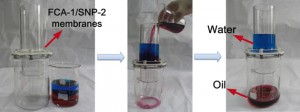Oil and water separation using the membrane. The water and oil were dyed by methyl blue and oil red, respectively
The membrane is made from a polymerised fluorinated polybenzoxazine (F-PBZ) layer on top of cellulose acetate nanofibres. The scientists used an electrospinning technique (in which a viscous liquid is passed through a conducting needle to form a thread) to create a porous structure that makes the membrane even better at absorbing the oil.
Interested to know more? Read the full article in Chemistry World here…
Read the article from Nanoscale:
In situ polymerization approach to the synthesis of superhydrophobic and superoleophilic nanofibrous membranes for oil/water separation
Yanwei Shang , Yang Si , Aikifa Raza , Liping Yang , Xue Mao , Bin Ding and Jianyong Yu
Nanoscale, 2012, Accepted Manuscript
DOI: 10.1039/C2NR33063F











